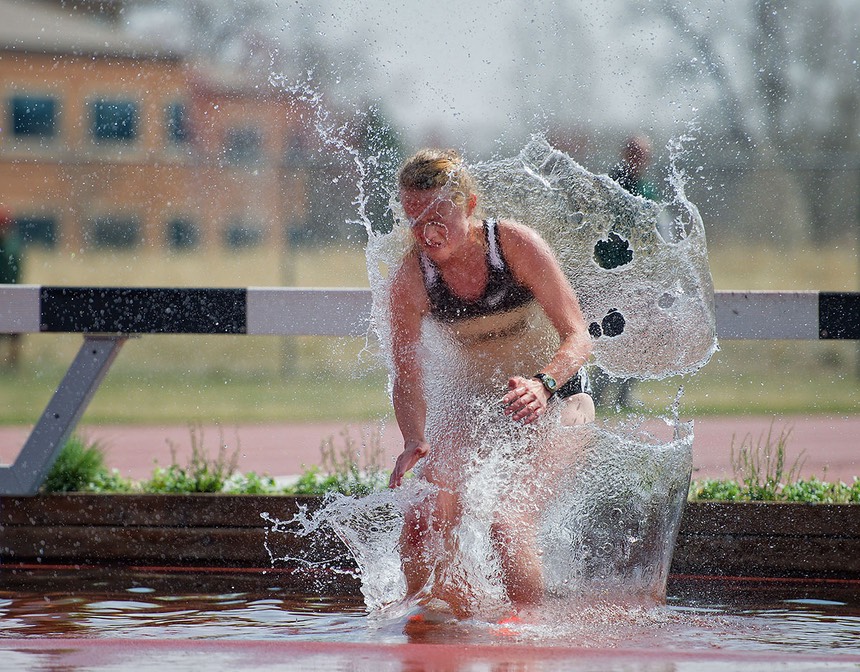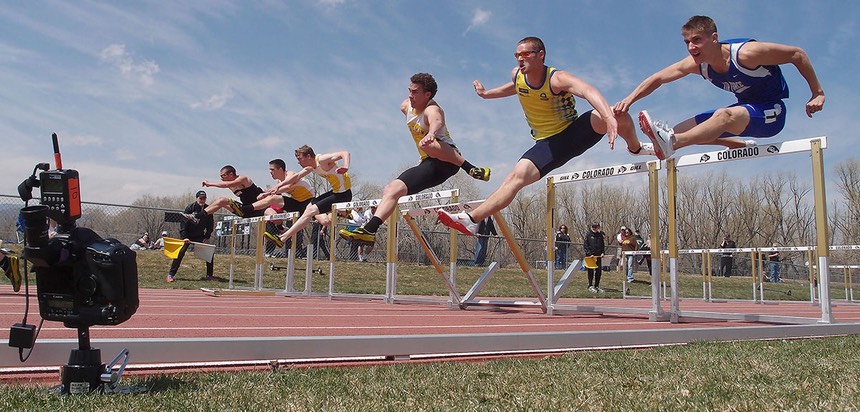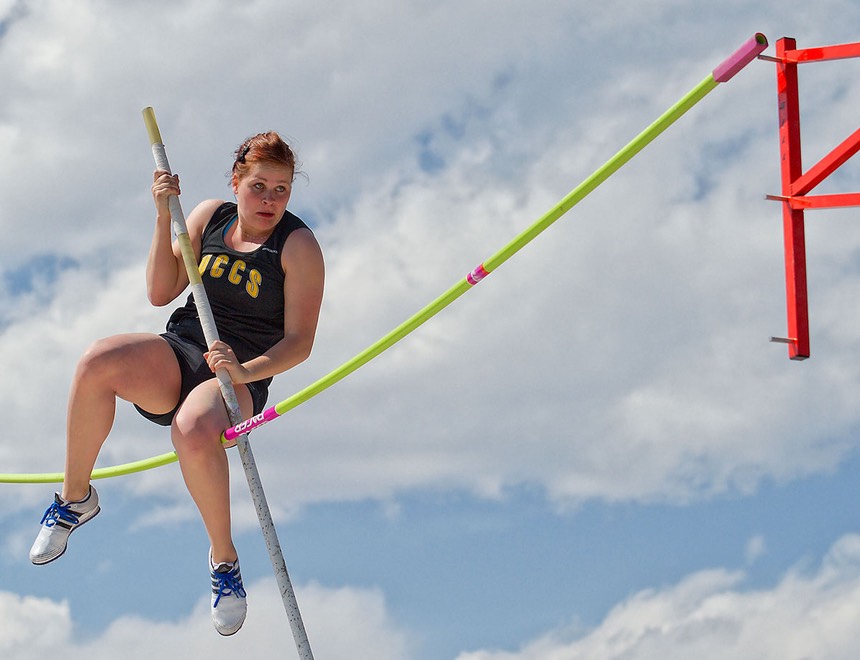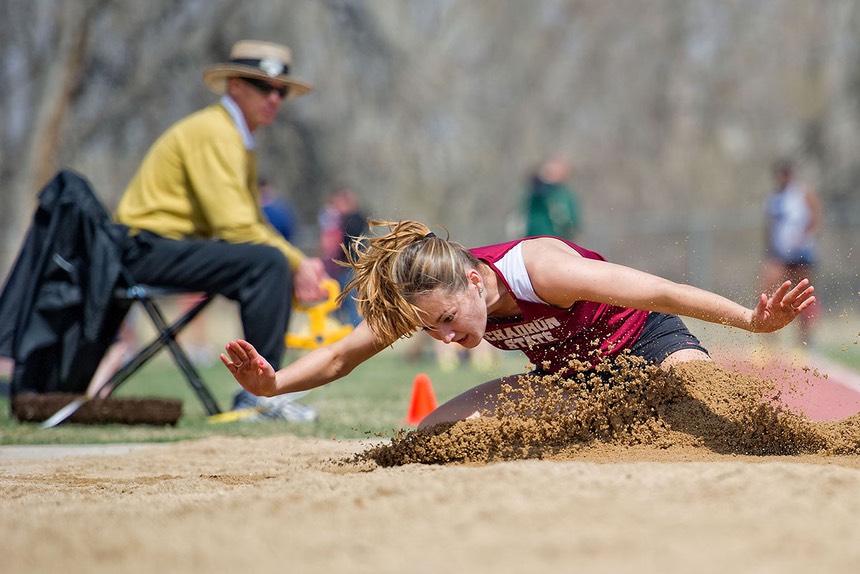All images in this story were taken in a single afternoon at a Peter Read Miller Sports Workshop. I can heartily recommend his workshops, which are intensive, helpful, and exhausting. Come prepared to shoot/edit/discuss 24/7. Likewise, I also highly recommend the Summit Workshops, too. It's another round-the-clock experience that will help you become a better sports photographer while getting extensive practice and feedback from some of the best sport photography practitioners. Both workshops have been going for over a decade. Every couple of years I attend one or the other workshop to get some much needed tuning and advice.
What can you learn from a sports photographer?
A lot.
I started photographing sports back in high school, and I had a sadistic mentor at the time that would send me to every sporting event with a different camera, one designed exactly wrong for the event.
What do I mean by that? He would send me to a track meet with a twin lens reflex camera, for example. You look down into the viewfinder of those TLRs and action moves the opposite way in real life from what you see in the viewfinder. Try to follow a runner via the viewfinder and you fight yourself, as the runner may be moving right to left in front of you (from an infield shooting position) but is moving left to right in the viewfinder! As I said, sadistic.
But there was a method to his madness. He was trying to break me from day one of any sense that all I had to do is show up and react to get great sports photos. He was trying to get me to plan.
Let me try a little experiment with you. You’re covering a track meet for me. The steeplechase is about to start. Where do you go to take pictures?
A steeplechase has lots of those big, high, wood beam hurdles, and one at least one positioned in front of a big pool of water. The event is about obstacles. So if you’re not standing near an obstacle, you’re fired as my photographer! Okay, where in relationship to the obstacle are you? I hope you said “in front.” Otherwise I’m not going to see the reaction on the faces of those poor participants who didn’t quite manage the obstacle the way they wanted. Face plants in water from the back aren’t going to make page two of Sports Illustrated.

Okay, so where exactly is your camera? I hope you said “on or near the ground." Why? Because that gives you more usable frames before the face hits the water. Heck, if you can set up right next to the water pit and use a remote to fire, you might get that perfect image that looks almost 3D. In the case of the photo, above, I had to compromise. I was photographing another event at the other end of the track when the steeplechase started and didn't have time to set up a wide-angle remote at the water. But note that even with the long lens I ran over with, I'm down low; I'm sitting on the ground with my monopod unextended.
Great, the steeplechase is now over and we’ve got the 100-meter hurdles. Now where are you, and why? I’ll accept some inventive answers here, including Bill Frake’s slit scan camera tracking with the front runner (seventh image in the gallery on that linked page), or being one of the group hoping to get the winner’s big exultation as they head into the corner when they realize that they won (bonus points for including the time clock).

Both events I just asked you about have the same answer: the photographer thinks about what’s going to happen, what they want to happen, where they want to be when it happens, and what they’ll need to shoot it from that position. Those are exactly the questions you should be asking yourself about any kind of photography:
1. What’s likely to happen?
2. What do I want to happen?
3. Where do I want to be when #1 or #2 happens?
4. What do I need to capture it?
It’s not f/8 and be there. It’s figure out where you need to be, then set f/8 ;~). But note that photo of the hurdles, above. Sports photographers often take photos from two places at once! You set up a remote camera, often with a wide lens, then find another position to create a different type of picture. You're firing both cameras simultaneously by using something like a Pocket Wizard. If there's a particular athlete you're following, you isolate on him or her with the second camera and let your remote capture the wider scene.
And yes, all four steps I outlined above apply to even something like landscape photography. When I see a photograph from somewhere I’ve been that is unlike any I’ve seen before—which is unusual, by the way, as most landscape photography seems to all be taken from the same permanent tripod set up at each place—I immediately go to question #3. Where was that photographer and why? Did I miss a #1 or #2 that happens, let alone figure out where I needed to be? I try to think through what the photographer was thinking as they answered those questions.
Of course, sometimes photographers just stumble upon something—it’s more than okay to be open to spontaneous attraction—but almost all the best photographers I know are control freaks. They started by asking some simple but essential questions. When does the sun rise is a #1 question that every landscape photographer should know. #2 has some additional intersection points, such what is the weather going to be like? I don’t want the sun to rise in a clear blue sky (most of the time), nor do I want cloud cover that blocks the sun. I can use Photographer’s Ephemeris to figure out #3, especially if I know the area well and can mix my knowledge with the maps it presents.
It’s funny, but most people get hung up on question #4 (even before they’ve answered #1, 2 or 3): they’re focused on the gear, not the photo.
I remember one pre sunrise Patagonia morning when I was out and shooting from a spot where I was trying to balance the town (El Chalten) against what I hoped would be a wild cloud light show around Fitzroy. It was doing just that when one of my students walked up, set his tripod up next to mine and then started asking me a set of equipment related questions: what focal length, what aperture, what shutter speed? Since I had just a day or two earlier finished a lecture that basically said “you can’t answer equipment questions until you know what you’re photographing,” my answer was “what are you taking a photo of?” In this case it was literally “what’s likely to happen, do I like what will happen, where do I want to be while it’s happening?” He had skipped past all that and was just going to do what I was doing.
Personally, I don’t think you learn as fast or as well by simply mimicking. Sometimes you don’t learn at all. Worse still, you walk away from the scene with nothing that will help you get that shot again (unless you just follow that photographer around and take photos when he takes photos). In this particular case I was trying to get a specific image for a publication. Not an image that was even necessarily the best one I could make with the wild sunrise we ended up with. Indeed, I broke from my setup the minute I knew I had the photo I wanted to go see if I could get a different image I had imagined—#1 and #2 again. (I should point out that this was not workshop time—we had over 8 hours of that planned for later in the day; if I recall correctly, only three students were out and about at the ungodly hour and wandering around looking for photos on their own.)

Since I wasn't covering this track meet for a publication, I didn't need to worry about capturing the winner of any event, including the often ignored pole vault. Instead, I concentrated on something else: seeing if I could get a photo of an athlete at the moment they realized they were or weren't going to succeed (following point #2). Note this athlete's eyes looking at the end of the bar. This was exactly the reaction type of image I was looking for. Oh, by the way, for extra credit: how did I focus? You guessed it: I'm prefocused on the center of the bar, with an aperture that'll give me some depth of field. If a jumper had come over the bar off center, I might hit the AF-On button to acquire a new focus point, but most of the time my autofocus motor sat silent. Even a consumer DSLR could have handled this.
Okay, how about wedding photography? Let’s again apply what the sports photographer is doing:
What’s likely to happen? What do I want to happen? Where do I want to be when it happens?
Only this time, the bride and photographer often conspire to make something happen ;~). The great photographers not only are great about spontaneously being in the right spot when spontaneous things happen, but are extremely good and manipulating their set pieces (bride, groom, location) to where they want them to be (#2 and #3 combined).
When I photograph events, especially for clients (such as brides), I’m highly manipulative. Perhaps it’s my filmmaking background, but I go deep into “director mode.” If the bride and groom are too close to the background, I move them. If I don’t like the background, we use a different one. If the bride wanted certain photos in her memory book, I make them happen. Of course, there are limits to what you can do. It’s getting fairly common for wedding ceremony locations to ban flash, ban many photographic positions, or disallow any pauses or placements suggested by the photographer, which puts me into spontaneous mode. This makes question #1 really, really important, and I only have a subset of possible answers for #3.
You may wonder how that paragraph applies to sports. Well, you don’t always take photos of athletes in competition. Sometimes you’re getting images for marketing and publicity purposes and you can go into “director” mode controlling when, what, and where. Yes, sports photographers do that all the time. They learned that from studio photographers (more "learn from others").
Aside: For events, walking around in cold not sure of what you're going to do is the worst enemy of the photographer. You should have scouted the location (#3), you should have talked to whoever is in charge of the event (as many of those who think they’re in charge as possible ;~) (#2), and you should have coordinated with the client about what they want and why (#1 and #2).
Okay, let’s say some magazine has decided to grant me Annie Leibowitz status and wants me to do a studio session of a celebrity totally under my control. If I’m in “full Annie” mode I want to control everything (#1 doesn’t happen, only #2 ;~). Celebrities, however, don’t always do what I want (or, for that matter, what anyone wants). I learned way back in undergrad school when I was doing TV shows with minor celebrities that #2 has to be a series of options. Yes, you want Whoopie Goldberg to take a bath in milk, but what if she doesn’t want to do that? You’d better have Plan B, Plan C, Plan D, Plan E, and as many other plans as you can whip up. But here’s another tip: they ALL need to be set up ahead of time. You can’t wait for someone famous to pick one of your plans and then wait around while you execute it. It’s move them to the part of the studio where you’ve got C set up, then ask if they’d mind sticking around and trying B and E, too? Oh, and question #4 had to have been answered and everything preset before they showed up at your door. I re-learned everything in this paragraph as a sports photographer mainly because the magazines and newspapers I worked for kept sending me to (minor) celebrities for posed sessions.
So let’s get fully back to sports to wrap up. Pull up any good sports photo site (e.g. something like the BBC's Sporting Photos of the Week). Can you post mortem answer the four questions for each of the images you see there? What was likely to happen? Did it happen? What did the photographer want to happen? Did it happen? Where did the photographer need to be to capture what happened? Why were they there? Did the photographer have the right gear and settings to complete the task? How did they know what that was?

This is another example of "why was I at that particular spot" photographer. I wanted the foot fault judge in the image as a spectator in the background. Too often we isolate too much in sports photography and just get an athlete (or even just a part of an athlete) and don't show context. My isolation images of the long jump are okay, but I tend to like the ones where I was trying to show something beyond just an isolated athlete. I was hoping I'd get another reaction (fault flag raised and athlete reacting), but none of the jumpers this day had any close calls that would have provoked that.
I had another semi-sadistic manager back when I was photographing college sports for Hughes Sports Network and ABC. His game was never to give me the same assignment twice. Sure, the team in my town played 15 home basketball games. Did my manager want the same thing from every game? Nope. That’s how it happened that I caught a moment no one else did, actually. My assignment for the game was “follow Bill Walton.” My manager didn’t want to see any image that didn’t have Bill Walton doing something in it.
Now, this isn’t as simple as it sounds. From almost any position I could be on the floor, there were many moments where I had no view of Walton. In fact, that turned out to be most of the time, as he kept going up to the high post that game. I finally moved my position from the traditional end line position to something different (had to do with the odd arrangement of the court being used: you could actually get relatively close to the court from a low balcony that overhung the teams benches). I was so scared of my NYC editor that I took his assignment literally. If the action was at the other end of the court and Walton was still at the far end, that’s where I was focused, which is how I caught him going down as a fast break moved rapidly away from him. Everyone else was focused on the steal and lay-in at the other end; I was still firing away at Walton on the floor at the other end. Indeed, no one else caught the critical moment when he went down with an injury that put him out of commission for a long time. The best anyone else had was an on-the-floor grimace after play had stopped.
I always think of that moment. Did my NYC editor expect something to happen? Did he want something to happen? The answer to those two questions were almost certainly yes, though he couldn't have anticipated exactly what would happen. Since he wasn’t in the arena to photograph the event himself, he controlled things from afar by making me concentrate on where he wanted the action to be, and he got it. Of course, it was a tiny bit out of focus and not perfectly framed, but it was the moment he was looking for and a usable image, so he only yelled at me a little.
